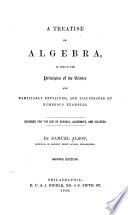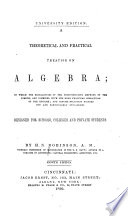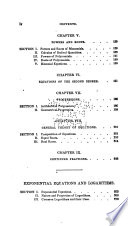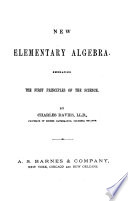 Any term may be transposed from one member of an equation to the other, provided its sign be changed. Any term may be transposed from one member of an equation to the other, provided its sign be changed.  Elementary Algebra - Page 31by Herbert Ellsworth Slaught, Nels Johann Lennes - 1915 - 373 pagesFull view Elementary Algebra - Page 31by Herbert Ellsworth Slaught, Nels Johann Lennes - 1915 - 373 pagesFull view - About this book
 | Samuel Alsop - Algebra - 1848 - 336 pages
...cleared of fractions by multiplying by the least common multiple of the denominators. 2d. Any quantity may be transposed from one member of an equation to the other by changing its sign. On these two rules depend all the methods of solving such simple equations as... | |
 | Horatio Nelson Robinson - Algebra - 1850 - 358 pages
...side with a contrary sign. From this we may draw the following principle or rule of operation : Amj term may be transposed from one member of an equation to the oiher, by changing its sign. Now 20a;=80. ax=-e. If we divide both members by the coefficient of the... | |
 | Benjamin Peirce - Algebra - 1855 - 308 pages
...— z~" from fractions and negative exponents. Ans. z4oa21 — a2x = a4lx2" — i2". 117. Theorem. A term may be transposed from one member of an equation to the other member, by merely reversing its sign ; that is, it may be suppressed in one member and annexed to the... | |
 | Thomas Sherwin - Algebra - 1855 - 262 pages
...the first, and changing its sign from — to +. ART. 19. Hence, any term affected by the sign — , may be transposed from one member of an equation to the other, if this sign be changed to -\- ; for this is adding the same quantity to each member. ART. 2O. Combining... | |
 | Samuel Alsop - Algebra - 1856 - 152 pages
...«54:. From the first of the above principles it follows that by changing the sign of any quantity it may be transposed from one member of an equation to the other, without destroying the equality. Thus, in the equation 4 x — 20 = 3 x + 56, the addition of 20 to... | |
 | Charles Davies - Algebra - 1859 - 324 pages
...sign of addition. 106. Therefore, for the transposition of the terms, we have the following RULE. Any term may be transposed from one member of an equation to the other, if the sign be changed. 105. What is transposition ? EXAMPLES. Transpose the unknown terms to the first... | |
 | Charles Davies - Algebra - 1860 - 328 pages
...diminished by 8 : hence, 2z = 36 - 8 = 28 28 , or x = — = 14. ii Hence, we see that a plus number may be transposed from one member of an equation to the other, by simply chang ing its sign to minus. Let x denote the son's age : then 2ж will denote the father's... | |
 | Charles Davies - Algebra - 1861 - 322 pages
...and Charles' share = 10 — 5 = 5. REMARK. — We see from the above example, that a negative number may be transposed from one member of an equation to the other by simply changing its sign to plus. 2. A person goes to a tavern where he spends three shillings :... | |
 | Thomas Sherwin - 1862 - 252 pages
...the first, and changing its sign from — to +• ART. 19. Hence, any term affected by the sign —, may be transposed from one member of an equation to the other, if this sign be changed to -|- ; for this is adding the same quantity to each member. ART. 2O. Combining... | |
 | Benjamin Greenleaf - 1863 - 338 pages
...we had transferred a from the first to the second member, and changed its sign. Hence the RULE. Any term may be transposed from one member of an equation to the other, provided its sign be changed. NOTE. It also follows, that the signs of all the terms of an equation may be changed, without... | |
| |